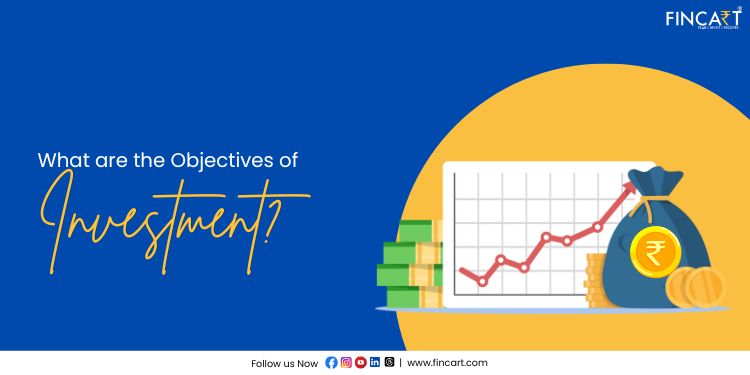Table of Contents
ToggleSaving money is important, but it isn’t enough on its own to realise all your financial dreams. To truly achieve your long-term financial goals, you need to invest. Investing allows you to increase the value of your money by buying assets that match your risk tolerance, financial goals, and investment horizon. There are different reasons for investing, and understanding these different objectives of investment can help you make better decisions.
When you understand your goals, you can put your money to work by creating a personalised investment strategy that works best for you. So what are the objectives of investment? Let’s answer that question and understand how these goals can guide your financial journey.
Objectives of Investment?
From wealth creation to minimising tax liability, there are many goals of investment. All these investment goals require different strategies and investment options. For example, low-risk investments like bonds are more suitable for individuals who can’t afford to take a lot of risk, while options like stocks are suitable for those with a higher risk tolerance. Here are the different objectives of investment and some of the options available to achieve them.
-
Capital Appreciation
Capital appreciation happens when the value of your investment increases over time. For example, if your parents bought a piece of land 20 years ago, its value today has likely grown to many times its original price. In other words, the value of the land appreciated. This increase in the value of an asset is a major objective for many investors, as it helps in wealth creation. Other than real estate, stocks and mutual funds are two popular investment options that can help you achieve this goal.
Two key forces drive capital appreciation – compound interest/ dividend reinvestment and the performance of the asset. For example, if you buy stocks that pay dividends, you can reinvest those dividends and buy more shares. Similarly, when you invest in mutual funds, the interest you earn also gets reinvested, thus allowing you to earn interest on interest and grow your wealth exponentially.
Also, the performance of the asset itself plays an important role. If a company performs well and its earnings grow, the price of the stock will also increase. Similarly, mutual funds that invest in a diverse portfolio of good stocks can help grow your wealth over time. Some instruments that can help in capital appreciation are:
- Stocks – Stocks are high-risk, high reward investment options. If you are investing in stocks, you must have considerable knowledge about the financial world, as well as risk mitigation techniques such as diversification.
- Equity Mutual Funds – When the scheme invests more than 65% of its assets in stocks of companies, it is categorised as an equity-oriented fund. These funds also offer very high potential for capital appreciation, but also come with high risks. By investing in these funds you can reap benefits such as compound interest, rupee cost averaging, professional management, and diversification.
The longer you stay invested, the more your capital will appreciate in value. And the risk becomes lower as well because you can ride out the short-term market fluctuations.
-
Income Generation
Generating income is another major objective of investing. For example, if you buy a house and you rent it out, you’ll generate a monthly rental income on your investment. Consulting an investment advisor can help you identify the best strategies for income generation. The main focus of income generation is to give investors a regular income stream from investments. Retired individuals are a great example of investors who benefit from income-generating investments, as they often rely on this steady income to support their day-to-day living expenses after they stop working. Here are some examples of income generating assets:
- Dividend Paying Stocks – Instead of reinvesting the dividends, one can choose to receive the dividends as cash payments and get a steady income stream.
- Annuities – Insurance companies offer annuity plans which are a low-risk option for generating a consistent income. The payments one receives may be immediate or deferred.
- Fixed Deposits – FDs are offered by banks and corporations. The FDs offered by banks come with lower risks and, consequently, lower returns compared to corporate FDs. Since corporations are competing with banks for investor funds, they tend to offer higher interest rates on their FDs, but this comes with an increased level of risk.
- Government Schemes – The government has launched various schemes such as the Post Office Monthly Income Scheme (POMIS), Senior Citizen Saving Scheme (SCSS), and Pradhan Mantri Vaya Vandana Yojana (PMVVY) for the benefit of retirees. Each of these schemes offers different features like fixed interest rates, tenure options, and tax benefits.
-
Capital Preservation
While capital appreciation refers to increasing the value of an investment, capital preservation refers to protecting your capital from loss. And while capital appreciation is a goal that is pursued by investors with a high risk appetite, capital preservation is more suited to risk-averse investors. That’s why before you invest, you must consider factors such as your income, investment horizon, emergency savings, age, and family responsibilities.
These factors will help you assess how much risk you can take, and allow you to choose between the two objectives accordingly. A major drawback of capital preservation is that inflation can diminish the real returns earned from safe investments over long periods. So if you are investing with long-term in mind, capital appreciation might be a better goal to pursue. Some options that can help you achieve this goal are:
- Debt Mutual Funds – As the name suggests, these funds invest in fixed income securities. They also help you grow your money but not as much as funds that have more exposure to equities. They are relatively safe and can help you preserve your capital while also giving you benefits such as professional management and diversification.
- Government Bonds – These bonds are issued by the government to raise funds for various purposes such as financing public infrastructure projects and public spending. Government bonds offer a lot of safety, as credit risk is eliminated.
- Treasury Bills (T-Bills) – The Reserve Bank of India issues T-bills and like government bonds, they are also used to raise money for the government’s short-term needs. Since they are also backed by the government, they offer high safety and are also highly liquid assets.
- Commercial Papers (CP) – Like T-bills are offered by the government to meet short-term funding, corporations offer commercial papers to finance short-term liabilities. However, unlike government-backed instruments, credit risk is associated with CPs.
- Other options include fixed deposits and Certificates of Deposit (CDs).
-
Tax Saving
Investing can save you a lot of taxes! Of course, everyone wants to save as much of their hard-earned money as possible, so another reason why people invest is to minimise their tax liabilities. Consulting with a tax consultant can also help identify opportunities for tax savings. The Income Tax Act of 1961 offers investors many deductions, exemptions, and benefits to legally save taxes. Here are some investment options that can help you do so:
- Equity-Linked Savings Scheme (ELSS) – These are also called tax-saving mutual funds because they offer annual tax benefits up to Rs. 1.5 lakh under Section 80C. These funds have a lock-in period of 3 years and invest mainly in equities.
- Unit Linked Insurance Plans (ULIPs) – ULIPs are a combination of insurance and investment. Think of them as mutual funds offered by insurance companies. Part of the premium you pay goes towards covering you, while the other part gets invested in a fund of your choice. ULIPs also offer Section 80C benefits, but beyond that, if you invest within a limit of Rs. 2.5 lakh annually in a ULIP, the maturity value also becomes tax-free.
- Government Offered Options – Investing in government schemes such as the Public Provident Fund (PPF), New Pension Scheme (NPS), and National Savings Certificate (NCS) can also help you save tax under Section 80C. NPS offers an additional tax benefit. Apart from the usual Rs. 1.5 lakh deduction under Section 80C, NPS offers a further deduction of Rs. 50 thousand under Section 80CCD (1B).
- Insurance – Health and term insurance can not only provide financial security and peace of mind to you and your family but also give you tax benefits! You can find health insurance tax benefits of up to Rs. 1 lakh under Section 80D for insuring yourself and your parents. Term insurance tax benefits can be found under Sections 80C, 80D and 10D.
Also Read: Best Tax Saving Investment Options for FY 2024-25
-
Diversification
Putting all your eggs in a single basket is dangerous. Diversification allows you to spread your investments across different asset classes to reduce risk. How does it work? Well, if you invest in a stock of a single company, your investment’s success or failure hinges entirely on that company’s performance. Should the company fail, its stock price will go down, and the value of your investment will fall significantly.
But if you invest in a basket of stocks from different companies, industries, or sectors, the impact of one company’s poor performance would be reduced by the good performance of others. This is just an example of a stock portfolio. Your investment portfolio should ideally have a mix of assets such as stocks, bonds, mutual funds, gold, commodities, and others. Different asset classes behave differently under market conditions, so you’ll benefit from a balanced portfolio.
This ‘mix’ is also called asset allocation, and it depends on your risk tolerance and investment goals. For example, if you are a high-risk investor, you’d allocate more of your assets in equities and less in debt. Similarly, a conservative investor’s portfolio would allocate a larger portion of assets to safer investments like debt funds, and a smaller portion to higher-risk assets such as stocks.
-
Beating Inflation
A big objective of investing is to beat inflation. Year after year, inflation can wipe away the purchasing power of your money. This means that if something costs you Rs. 100 today, it will cost you Rs. 106 next year if inflation continues at 6% per year. Thus the same amount of money will buy fewer goods and services over time as prices rise.
Keeping your savings in your bank’s savings account is hence a poor decision, as these accounts rarely offer inflation-beating returns. That’s why you should always invest your money in instruments that offer returns higher than the average inflation rate of the past few years. Gold is considered as a good hedge against inflation by many experts. These days one can invest in non-physical gold assets such as Sovereign Gold Bonds (SGBs), Gold ETFs, and digital gold.
-
Meeting Specific Financial Goals
Investing helps you achieve life’s financial milestones such as buying your first home, sending your child to a prestigious college for higher education, planning your dream wedding, and preparing for a peaceful life after retirement. These financial goals must be specific and clearly defined, as it makes your investment strategy more effective and helps you select the most suitable investment options.
-
Risk Management
Investments come with varying levels of risk. Managing this risk is important because it helps protect your capital and makes sure that your investment strategy aligns with your financial goals and risk tolerance. Here are some ways you can manage risk:
- Emergency Fund – Life is full of uncertainties, and unexpected expenses pop up from time to time. A big doctor’s bill or a loss of employment can not only stop your investing progress but also force you to sell your investments prematurely. In some cases, these expenses might even lead to debt. An emergency fund is a reserve of cash that acts as a financial safety cushion in case these unforeseen citations come up. It contains up to six months of your living expenses and allows you to continue your life without having to disrupt your investment strategy or incur debt.
- Insurance – Term insurance can cover your family’s financial needs in case something unfortunate happens to you, and health insurance can protect you from the ever increasing costs of medical expenses.
- Diversification – Having your portfolio spread across a variety of investments is important to manage investment risk.
Ready to grow your wealth?
Partner with Fincart for expert investment planning and make your money work for you.
Conclusion
There are many reasons to invest, and each reason plays an important role in securing your financial future. Investing not only helps you protect your money’s value from inflation but also allows you to create wealth in the long term. It helps you save tax and can generate income for various investment goals. The best thing about investing today is that it is accessible to anyone. Digital platforms and online tools have made investing much more convenient.
For example, with SIP you can start small and reap big rewards over time. It’s never too late to become an investor, but one should start as early as possible. Before you invest, however, it could be a wise move to consult with a financial advisor. A professional can assess your financial situation and risk tolerance, and create a plan that aligns with your investment objectives.
Start your investment journey today!




